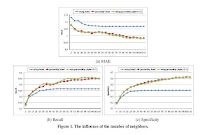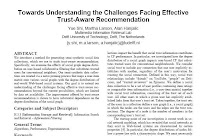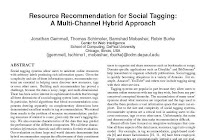September 26, 2010. It includes all these papers:
- "Credibility-aware Web-based Social Network Recommender: Follow the Leader"
".. credibility based clustering derived from the Follow_the_Leader model provides a highly effective approach to identify Top-N recommenders, who are leaders in the context with the highest trustworthiness and expertise among all users." equation (11) outlined in section 4.3, replacing similarity weight in [Massa, P. and Avesani, P., Trust-aware recommender systems. in, (2007), ACM, 24.] to credibility weight.


- "Augmenting Online Video Recommendations by Fusing Review Sentiment"


- "Using Personality Information in Collaborative Filtering for New Users" (MUST READ PAPER)
".. we propose a method that combines human personality characteristics into the traditional rating-based similarity computation in the framework of user-based collaborative filtering systems with the motivation to make good recommendations for new users who have rated few items." ".. The most commonly used similarity calculation method is Pearson correlation coefficient ... We adopt [ a ] modified correlation-based similarity score in our evaluation experiment .." we compare the performances of rating-based similarity (RBS), personality-based similarity (PBS) and their hybrid (RPBS) in different start-up settings." Figure 1 shows how RPBS and PBS are better models than RBS (in a sparse music dataset)




- "Rating items by rating tags"


- "Improving Link Analysis for Tag Recommendation in Folksonomies"
- "Towards Understanding the Challenges Facing Effective Trust-Aware Recommendation"


- "Toward a Design Space for the Recommendation of Communities"
- "Collaboration and Reputation in Social Web Search"
- "Niche Trend Search for Recommender System based on Knowledgeable Blogger Group"
- "Resource Recommendation for Social Tagging: A Multi-Channel Hybrid Approach"



- "Weighted Content Based Methods for Recommending Connections in Online Social Networks"
HAVE YOU SEEN how the word SIMILARITY has different meanings for different persons or companies?
DO NOT use or DO NOT try to adapt ANY of the FORMULAS suggested by the above papers (for serious online dating proposals) because your Online Dating Site will reach "as low as" 3 to 4 persons high compatible per 1,000 persons screened, so in a 1,000,000 women database, any man will see as many as 3,000 to 4,000 women to contact (nearly at the same time), that means, a whole precision LESS than anyone could achieve by searching on one's own!
In previous posts I had analyzed:
"Personality Similarity calculation paper: A Novel K-Means Based Clustering Algorithm for High Dimensional Data Sets"
and
"Recommender System for Online Dating Service"
If you want to see how to solve that problem, please see the post
"the online dating sound barrier"
The Online Dating Industry for serious daters DOES NOT need to be more social. It needs to be more effective.
The Online Dating Industry for serious daters does not need a 10% improvement, a 50% improvement or a 100% improvement.
It does need "a 100 times better improvement"
Breaking "the online dating sound barrier" is to achieve at least:
3 most compatible persons in a 100,000 persons database.
12 most compatible persons in a 1,000,000 persons database.
48 most compatible persons in a 10,000,000 persons database.
100 times better than Compatibility Matching Algorithms used by actual online dating sites!
The only way to achieve that is:
- using the 16PF5 normative personality test, available in different languages to assess personality of members, or a proprietary test with exactly the same traits of the 16PF5. The ensemble of the 16PF5 is: 10E16, big number as All World Population is nearly 6.7 * 10E9
(WorldWide, there are over 5,000 -five thousand- online dating sites, but no one is using the 16PF5)
- expressing compatibility with eight decimals, like The pattern 6.7.6.8.9.6.7.7.8.7.2.5.8.7.3.4 is 92.55033557% +/- 0.00000001% similar to the pattern 7.7.6.8.8.7.6.5.8.7.4.5.7.7.3.4
Using a quantized pattern comparison method (part of pattern recognition by cross-correlation) to calculate similarity between prospective mates.
No comments:
Post a Comment